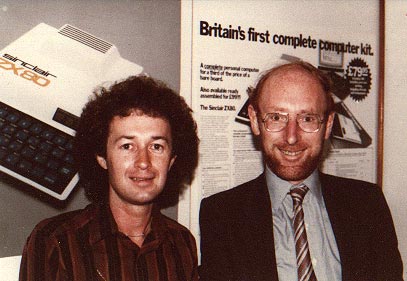
HISTORY OF HOME AND GAME COMPUTERS

| Navigator | ||||||||||||||||||
|
|
|
|
||||||||||||||||
|
|
||||||||||||||||||
Welcome to the nostalgic
history of home and game computers
![]()
SINCLAIR ZX80 -
the first affordable home computer
|
|
Unbelievable prices
Like the mini-radio's
Sinclair's company had manufactured, the ZX80 was available both as a
self-assembly kit and as well as ready-built. Hobbyists who weren't reluctant to
handle a soldering iron only had to pay 79,95 British pounds. Less skilful
people could buy the ready-built computer for 95,95 pounds, including postage.
(Sinclair at that time mainly sold his products by mail.)
Thus the ZX80 was the first computer that dove under the magic 100-pounds-limit,
making it possible for many more people to use a computer at home or in their apartments. Abroad the
ZX80 also destroyed the price-limits: in the United States the price for a
ready-built one was 199,95 dollar and in Western-Germany consumers had to pay
498 mark.
 Clive Sinclair (right) |
Waterproof The slogans in Sinclair's advertising of course emphasized the low prices. But, of course, the ZX80 had also other advantages. With its compact plastic case and membrane 'keyboard' the ZX80 was waterproof, so using the computer and drinking beer at the same time was also a possibility provided by Sinclair. Also handy were the multifunctional keys, with which whole Basic-commands could be entered by one touch. And endless searching for that one annoying error in a Basic-listing wasn't necessary anymore, because the ZX80 checked every program rule before acceptance with the so-called syntax check. |
Short programs
Although, even without syntax check endless searching for errors wouldn't have
been necessary, because with its 1K RAM the ZX80 could only contain very short
programs. Sinclair swiftly began manufacturing memory extensions that could be
plugged into the back of the computer. Initially these were modules with 1 to 3K
RAM, depending on the amount of money the consumer wanted to spend. Afterwards,
when the prices of the required chips dropped, Sinclair started to sell modules
of 16K RAM. These made those little computers a bit more mature.
It is clear that the consumer for his 100 pounds got not more then a very basic
home computer, and in fairness he couldn't have expected more. A sober
black-and-white performance, no sound and although multifunctional and
waterproof, an awkward keyboard when intensively used.
Cloak of charity In the first reviews these shortages were covered yet with the cloak
of charity. When the ZX80 was just introduced, a critic of Personal
Computer World even wrote very positively about the membrane keyboard. He
even seemed to like it that the display switched off every time you
touched a key (the CPU couldn't receive input and care for the display at
the same time), because the flickering made clear the touch of the key had
been successful. (Don't forget, this was 1980.) In the first reviews these shortages were covered yet with the cloak
of charity. When the ZX80 was just introduced, a critic of Personal
Computer World even wrote very positively about the membrane keyboard. He
even seemed to like it that the display switched off every time you
touched a key (the CPU couldn't receive input and care for the display at
the same time), because the flickering made clear the touch of the key had
been successful. (Don't forget, this was 1980.)But a few years later the love for the ZX80 didn't exist anymore at Personal Computer World. Quote: 'With an unusable keyboard and a quirky BASIC, this machine discouraged millions of people from ever buying another computer.' |
 test program |
Soon you'll find here more about the other computers from Sinclair and about Sinclair himself, who received a knighthood in 1983 at the instigation of Margareth Thatcher, and from that moment on could call himself 'Sir'. |
Specifications of the Sinclair ZX80
| Manufacturer | Science of Cambridge, later Sinclair Research |
| Period | January 1980 - March 1981 |
| CPU | NEC 780C-1 (Z80A compatible) |
| Frequency | 3,25 MHz |
| ROM | 4 KB |
| RAM | 1 KB |
| Text mode | 32 x 24 |
| Graphical mode | 64 X 48 (by half characters) |
| Colours | black-and-white |
| Sound | none |
| I/O | TV, cassette, extension port |
| Price | 100 British pound / 200 dollar
ready-built 80 British pond for a self-assembly kit |
|
|
||
| News | |||
|
|
|
|
|
|
|
|||
View results from last poll: how many games you have? (3127 votes)
 In
the beginning of 1980... there was the Sinclair ZX80. This remarkable device was
the first really affordable home computer. Just like the other inventions of the
Briton Clive Sinclair, the ZX80 was a device in mini-size. Unbelievable flat for
a computer, a bit less then 20 centimetres in width and a bit more then 20 in
length. A fine achievement, almost after the motto of the chain smoker Sinclair
that designers always should keep the size of a pack of cigarettes in
mind.
In
the beginning of 1980... there was the Sinclair ZX80. This remarkable device was
the first really affordable home computer. Just like the other inventions of the
Briton Clive Sinclair, the ZX80 was a device in mini-size. Unbelievable flat for
a computer, a bit less then 20 centimetres in width and a bit more then 20 in
length. A fine achievement, almost after the motto of the chain smoker Sinclair
that designers always should keep the size of a pack of cigarettes in
mind. 
